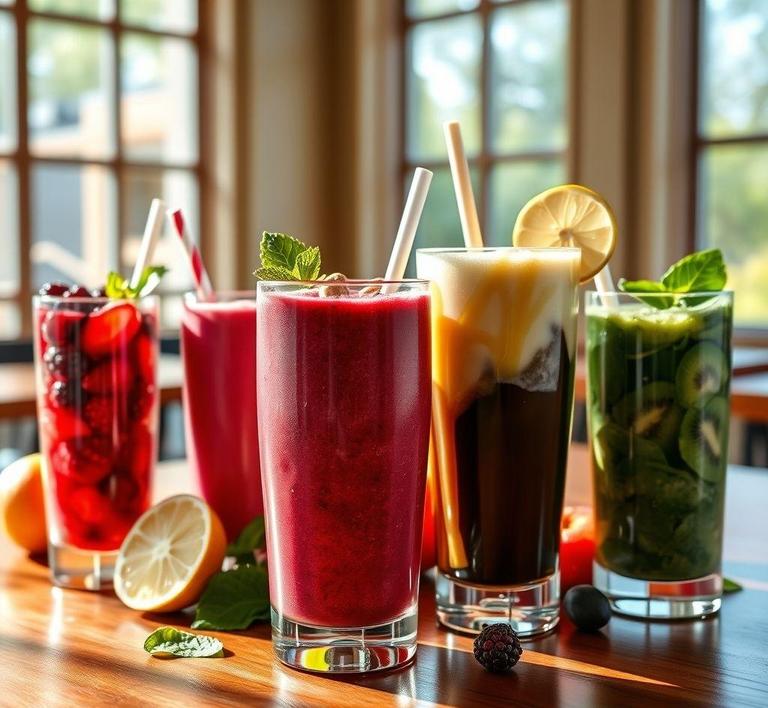If you’re someone who loves smoothies but struggles with how to store them for later, the refreeze smoothie method is about to become your new best friend. Imagine being able to prep your favorite smoothies in advance, freeze them, and then simply refreeze them for a fresh and delicious treat whenever you want. This guide is packed with all the tips and tricks you need to make the most out of refreezing smoothies, from choosing the right ingredients to ensuring they stay flavorful and nutritious. Whether you’re meal prepping for the week or just need a quick and refreshing snack, the refreeze smoothie technique will save you time while keeping your smoothies fresh and easy to enjoy!
Can You Refreeze Smoothie?

The simple answer to this question is: yes, you can refreeze a smoothie. However, the process comes with several caveats. Let’s first explore why you might be considering refreezing in the first place.
Smoothies are a versatile and delicious option for breakfast or a snack, often made from a mix of fruits, vegetables, yogurt, milk, or other liquids. If you’ve prepared too much and want to save the leftover portion for later, the idea of freezing it seems like an easy solution. But sometimes, after defrosting a smoothie, you may find yourself with more than you can consume in one sitting. In these cases, the possibility of refreezing may come up, but it’s crucial to consider the various factors that affect the quality, texture, and flavor.
How To Refreeze Smoothie?
Refreezing a smoothie is possible, but the method you use is important to preserve as much of the original texture and flavor as possible. Here’s a step-by-step guide to help you refreeze a smoothie with minimal impact on its quality:
1. Assess The Smoothie’s Composition
Smoothies with high water content, such as those made with fruits like watermelon or cucumber, tend to freeze and thaw with more noticeable texture changes compared to thicker smoothies with ingredients like avocado, banana, or yogurt. Be mindful of the ingredients in your smoothie, as some may not freeze as well or may undergo more significant texture changes.
2. Check For Any Defrosting Concerns
Before refreezing, you should first ensure that your smoothie hasn’t been left out at room temperature for too long. According to food safety guidelines, perishable items should not be left unrefrigerated for more than two hours. If your smoothie has been sitting out for longer, it may not be safe to refreeze. Always prioritize food safety, especially when dealing with dairy-based smoothies.
3. Pour The Smoothie Into A Container
If the smoothie has already been defrosted but hasn’t been consumed, you can attempt to refreeze it. Pour the smoothie into a tightly sealed container or a freezer-safe bag. Make sure to leave a bit of space at the top of the container, as liquids expand when frozen. If you’re using a freezer-safe bag, squeeze out as much air as possible to reduce the chances of freezer burn.
4. Freeze Promptly
Place the smoothie back in the freezer as soon as possible. The key to maintaining the best possible quality is minimizing the time spent at room temperature. If you’re unsure about the condition of the smoothie, it’s best to consume it after defrosting, as repeatedly freezing and thawing can significantly degrade its quality.
5. Thawing After Refreezing
When you’re ready to drink the refrozen smoothie, let it thaw in the fridge for several hours. For best results, avoid using the microwave, as it can disrupt the texture even further. Once thawed, stir the smoothie to recombine any separated ingredients and enjoy!
Quality Impact
Refreezing a smoothie will inevitably have some impact on its texture and flavor. The degree to which it affects the smoothie depends largely on the ingredients used and the number of times it has been frozen and thawed.
1. Texture Changes
One of the most noticeable effects of refreezing a smoothie is a change in texture. The freezing process causes the water content in the smoothie to form ice crystals. When these crystals melt, they can break down the smooth, creamy consistency that is characteristic of a freshly made smoothie. Refrozen smoothies tend to become more watery or grainy, as the separation of liquid and solids becomes more pronounced.
The type of liquid you use in the smoothie also plays a significant role. Smoothies made with yogurt or nut butters often hold up better than those made with high-water fruits. This is because the proteins and fats in yogurt and nut butters stabilize the mixture to some extent. Conversely, fruit-heavy smoothies tend to break down into watery layers and lose their smooth consistency upon refreezing.
2. Flavor Deterioration
Alongside texture, the flavor of the smoothie may be slightly altered after refreezing. The freezing process can dull some of the more delicate flavors, especially those from fresh fruits like berries, citrus, and tropical varieties. The flavors may become more muted or even slightly off, particularly if the smoothie was stored for a long time before refreezing.
Additionally, smoothies containing dairy or dairy substitutes may undergo changes in flavor after the freezing process. The freezing and thawing can sometimes cause the fats in dairy to separate, leading to a less pleasant mouthfeel. Over time, refreezing can also amplify the oxidation of certain ingredients, which might make the smoothie taste less fresh.
3. Nutritional Degradation
While freezing preserves most of the nutrients in a smoothie, repeated freezing and thawing can cause a slight decline in nutritional quality. Certain vitamins, such as vitamin C and some B vitamins, are sensitive to temperature changes and may break down slightly with each freeze-thaw cycle. This can lead to a minor reduction in the nutritional value of your smoothie, but the overall impact is usually minimal. If you’re looking to preserve the most nutritional benefit, it’s best to consume smoothies shortly after they’re made or only freeze them once.
4. Freezer Burn
A common issue when refreezing smoothies is freezer burn, which can affect the texture and taste. Freezer burn occurs when food is exposed to air in the freezer, leading to dehydration and oxidation. To prevent this, make sure your smoothie is tightly sealed in an airtight container or bag. The less air exposure, the better.
Refreezing a smoothie is indeed possible, but it comes with some trade-offs in terms of texture, flavor, and overall quality. While it’s generally safe to do so, you’ll notice that repeated freezing and thawing can degrade the creamy, fresh consistency of the smoothie, especially if it’s made with high-water fruits or contains dairy. For the best results, try to consume smoothies soon after thawing and minimize the number of times you freeze and thaw them.
If you’re planning to refreeze a smoothie, ensure you do so with care. Store it properly, minimize air exposure, and try to consume it within a reasonable time frame after refreezing. Ultimately, while refrozen smoothies may not match the original texture and taste exactly, they can still make for a refreshing, nutritious, and convenient snack.
Is It Safe To Refreeze A Smoothie?
Refreezing a smoothie can be a convenient way to preserve leftover beverages, but the safety and quality of the smoothie after refreezing depend on several factors. First and foremost, it is important to understand that smoothies are a mixture of fruits, vegetables, liquids, and other ingredients like yogurt or protein powder. Each of these ingredients reacts differently to freezing and thawing, which influences both safety and taste.
From a safety standpoint, refreezing smoothies is generally safe as long as they’ve been handled properly before freezing in the first place. If a smoothie has been thawed at room temperature for an extended period (more than two hours), bacteria may have begun to grow, making it unsafe to refreeze. On the other hand, if the smoothie has been thawed in the fridge and not left out, you’re in a safer zone for refreezing.
That said, repeated freezing and thawing cycles can degrade the texture and taste. Smoothies, like most frozen foods, can lose their vibrant flavor and smooth consistency after thawing and refreezing. The key issue here is the breakdown of the ingredients, especially watery components like fruits and vegetables, which tend to separate and become mushy upon refreezing. So, while it may not pose a direct health risk if done correctly, the quality of the smoothie will likely suffer.
Signs That Smoothie Should Not Be Refrozen
Recognizing when a smoothie should not be refrozen is essential to maintaining both its safety and quality. Here are some signs that should prompt you to discard the smoothie instead of attempting to refreeze it:
- Spoiled Smell or Taste: A sour, rancid, or off-putting odor is a clear indicator that the smoothie has gone bad. If the taste is off-tangy or too bitter-it may have begun to ferment or spoil. If you detect such signs, it’s best to throw it away to avoid the risk of foodborne illness.
- Separation of Ingredients: If the smoothie has been thawed and you notice that the ingredients have separated significantly-where the liquid is at the bottom and chunks of fruit or yogurt are floating-this may be a sign that the texture will degrade further upon refreezing. While separation is common when smoothies thaw, excessive separation might indicate that the smoothie will not blend back to its original form after refreezing.
- Visible Ice Crystals: If the smoothie has formed large ice crystals when thawed, it means that the liquid has expanded during freezing, causing texture issues. Refreezing it could cause these ice crystals to grow larger, resulting in a grainy texture that’s unpleasant to drink.
- Long Periods of Thawing: If the smoothie was left at room temperature for longer than two hours, it’s advisable not to refreeze it. Bacteria multiply quickly at room temperature, so consuming or refreezing it after such an extended thawing period can lead to foodborne illness.
Common Refreezing Mistakes
While the idea of refreezing a smoothie seems straightforward, there are some common mistakes that can compromise both the safety and quality of the smoothie:
- Refreezing Without Proper Thawing: One common mistake is refreezing a smoothie without properly thawing it first. If you freeze the smoothie in a block of ice without breaking it down, it can lead to inconsistent textures when thawed again. Freezing smoothies in smaller, single-serving portions helps maintain a more even consistency and prevents large ice chunks from forming.
- Thawing at Room Temperature: Thawing a smoothie at room temperature for extended periods before refreezing encourages bacterial growth. It’s best to thaw the smoothie in the refrigerator if you plan to refreeze it later. This way, the smoothie stays at a safe temperature and bacteria are less likely to multiply.
- Refreezing After Multiple Thawing Cycles: Refreezing a smoothie that has already been thawed once (and possibly refrozen before) can exacerbate the breakdown of ingredients, especially if the smoothie contains dairy or protein powders. The more times a smoothie goes through the freezing-thawing cycle, the worse the texture and flavor will become.
- Not Using Airtight Containers: Refreezing smoothies in containers that are not airtight can lead to freezer burn. Freezer burn occurs when air comes into contact with the food, causing it to dehydrate and lose flavor. Always make sure your smoothie is stored in an airtight container or freezer bag to maintain its quality.
- Using Old Ingredients: If the ingredients used to make the smoothie were already near the end of their shelf life before freezing, refreezing will not improve the quality of the smoothie. Overripe or moldy fruit can quickly degrade in flavor and texture when frozen again.
Tips And Tricks
If you decide to refreeze a smoothie, there are several tricks you can use to improve both the safety and the quality of the beverage:
- Freeze in Portions: To make refreezing easier, freeze smoothies in individual servings. You can use ice cube trays, silicone molds, or even freezer bags divided into sections. This allows you to defrost and refreeze only the amount you need without sacrificing the entire batch.
- Add a Thickener: When preparing smoothies that will eventually be refrozen, consider using ingredients that help stabilize the texture, such as chia seeds, flaxseed, or avocados. These ingredients help maintain a smooth and creamy texture even after multiple freezes.
- Use Vacuum Sealing: For an optimal freezing experience, use a vacuum sealer to remove all the air from the storage bag or container. This prevents freezer burn and helps preserve the flavor and nutritional content of the smoothie.
- Quick Freeze: If you’re making a batch of smoothies that you plan to refreeze, consider flash freezing the smoothie in an ice cube tray first. Once the cubes are solid, transfer them into a sealed container or freezer bag. This helps prevent large ice crystals from forming and preserves the texture better.
- Stick to Basic Ingredients: If you’re unsure about refreezing a smoothie, try sticking to simpler, more stable ingredients like frozen berries, bananas, and a bit of almond milk. Avoid ingredients like yogurt, protein powders, or dairy-based liquids, as these tend to degrade in texture after refreezing.
Conclusion
Refreezing smoothies can be a practical way to make the most out of leftovers or preserve a batch for later use, but it’s crucial to do it carefully to maintain both safety and quality. While it’s generally safe to refreeze a smoothie if it’s been handled properly-kept cold and stored in an airtight container-there are several pitfalls to avoid. Watch for signs of spoilage, don’t make the mistake of refreezing smoothies that have been improperly thawed or left at room temperature for too long, and always take care to freeze your smoothie in a way that will minimize texture degradation.
By following proper refreezing techniques and being mindful of the potential for texture changes, you can continue enjoying smoothies even after they’ve been frozen and thawed. However, for the best flavor and consistency, it’s often better to consume smoothies immediately after making them or to freeze them once, in small portions, rather than going through repeated freezing and thawing cycles.


